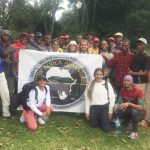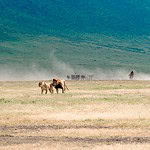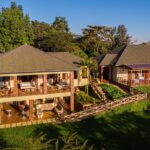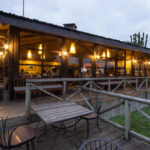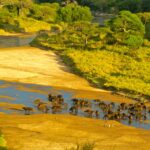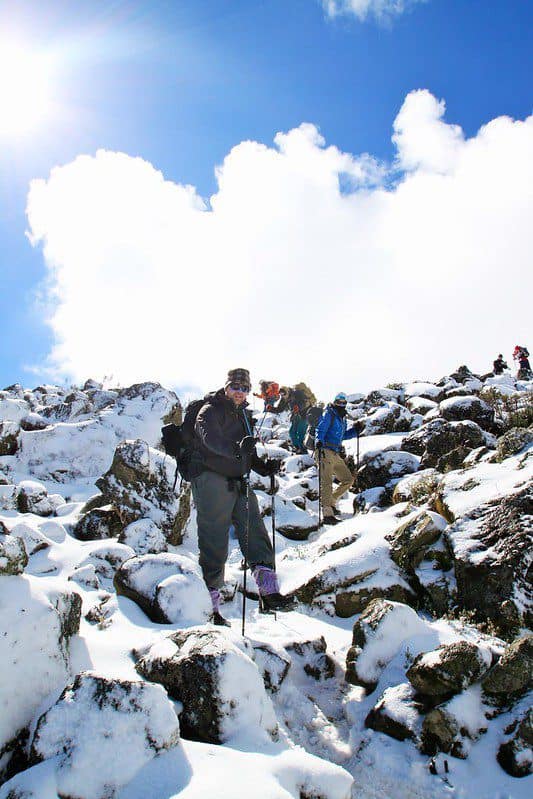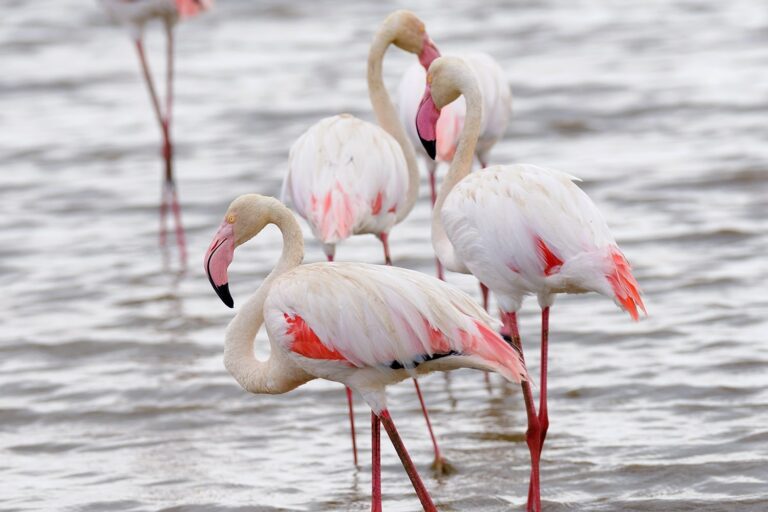Africa Mount Kilimanjaro is one of Africa’s most treasured.
When you imagine Africa’s most iconic mountain, one name always comes to mind, and that name is Africa Mount Kilimanjaro. Majestically standing in northern Tanzania, Africa Mount Kilimanjaro is not only Africa’s highest peak, it is one of the most popular high-altitude mountains worldwide for trekkers and adventure-seekers, or for that matter, people who just want to conquer Africa Mount Kilimanjaro and say they have touched the ‘Roof of Africa.’
In this guide, we will lead you through all that you need to know about Africa Mount Kilimanjaro, from facts and history, through routes and costs, and all the way to wildlife and helpful advice on conquering Africa Mount Kilimanjaro.
If you are going on an expedition with Snow Africa Adventure, continue reading and get a complete idea of what Africa Mount Kilimanjaro has in store for you.
1. Where is Africa’s Mount Kilimanjaro Located
Africa Mount Kilimanjaro Geographically, Africa Mount Kilimanjaro is situated close to the Kenya-Tanzania border, near the northeastern part of Tanzania. Africa Mount Kilimanjaro is inside Kilimanjaro National Park, a World Heritage site that was established way back in 1987.
Africa Mount Kilimanjaro is surrounded by a diverse and beautiful landscape, ranging from fertile farmland on its southern slopes to open plains and Africa Mount Kilimanjaro itself, towering above these surroundings.
Because Africa’s Mount Kilimanjaro is a free-standing massif, as opposed to a mountain range, it is a prominent feature of its environment, easily identifiable from many kilometers away due to its distinctive appearance compared to its surroundings.
2. Height & Geology of Africa Mount Kilimanjaro
Among the first questions that most trekkers asking about Africa Mount Kilimanjaro have is, “How tall is it?” Africa Mount Kilimanjaro has a peak of about 5,895 m (19,341 ft) above sea level, and this is measured at the Uhuru Peak of its Kibo cone.
Africa Mount Kilimanjaro has three volcanic cones namely Kibo, Mawenzi, and Shira, of which Kibo is the highest cone.
Kibo is dormant, but it is potentially active, while Mawenzi and Shira are extinct volcanoes. Africa Mount Kilimanjaro has its formation due to volcanic activities occurring along the East African Rift Valley, and its great elevation makes this mountain a wonder of nature.
3. Why Climb Africa Mount Kilimanjaro
• The Achievement
Reaching Africa’s Mount Kilimanjaro is a prestigious feat because it is Africa’s highest peak and one of the Seven Summits, considered the highest mountains on each continent on Earth.
• The Vertical Journey
Of its kind, Africa Mount Kilimanjaro is distinctive for its large vertical range of climatic conditions on ascent, including tropical rainforests at its foot, followed by moorlands, then alpine deserts, and culminating in snowfields before reaching its peak.
• Natural & Cultural Resources
In addition to this natural difficulty, Africa Mount Kilimanjaro provides opportunities for some great exposure to local culture, beautiful scenery, and getting into a world that only a select few have experienced.
• Accessibility
Though this can be a tough hike, Africa’s Mount Kilimanjaro is non-technical for its easiest ways, and this means that you won’t need any ice axes or fixed ropes on many of its popular routes.
4. Best Routes Up Africa Mount Kilimanjaro
There exist a number of popular routes that lead one to the pinnacle of Africa’s Mount Kilimanjaro, each offering a diverse experience and varied difficulty and scenic views. Some of these are as follows:
- Marangu Route: Also known as the “Coca-Cola” route, as it has hut accommodation and is of relatively.
- Machame Route: Very popular, scenic, more challenging, great acclimatization.
- Lemosho Route: More isolated, fewer people, more scenic, longer (results in improved success chances).
- Rongai Route: Approaches from the north, quieter, drier side of Africa, Mount Kilimanjaro.
- Northern Circuit: The longest and most gradual climb on Mount Kilimanjaro, Africa, and is great for acclimatization and scenic shots.
Choosing the route that is most appropriate for your group when climbing Africa’s Mount Kilimanjaro is essential for success.
5. When to Climb Africa Mount Kilimanjaro
It is essential that you time your ascent up Africa’s Mount Kilimanjaro because this has a great effect on the climatic conditions and levels of congestion on that mountain.
Dry seasons:
Prime time for Africa Mount Kilimanjaro climbs is during June and October, and December and February; clear skies and trails.
Wet seasons:
- Long rains: these occur towards the end of spring, from April to May.
- Short rains: these occur from November, marking the end of autumn.
If success is your aim on Africa’s Mount Kilimanjaro, then the dry season and an early booking are essential.
6. Physical and Equipment Considerations for Africa Mount Kilimanjaro
Physical Training
To conquer Africa’s Mount Kilimanjaro, one would need strong cardiovascular and leg muscles and stamina. Training would involve walking with heavy weights, stair climbed, and Cardio and Strength Training.
Basic Kit
For Africa Mount Kilimanjaro, you’ll need:
- Sturdy hiking boots
- Warm clothing (this is a tropical bottom and sub-zero top mountain range)
- Waterproof outerwear
- Sleeping bag designed for low temperatures
- Trekking poles
- Sun Protection (the sun is strong at high altitude)
Altitude Awareness
One of the hardest elements of Africa’s Mount Kilimanjaro is altitude. Even if you find that technical climb not too strenuous, cumulative altitude could be a problem for you. Getting acclimatized and paying attention to your body is imperative for a successful climb.
Choose a Reputable Operator
When hiking Africa’s Mount Kilimanjaro, it is essential that one hire a seasoned expedition company, such as Snow Africa Adventure, because of logistics, safety, equipment, and humanitarian issues relating to local guides and porters.
7. Cost and Logistics of Africa Mount Kilimanjaro
The price of African Mount Kilimanjaro can vary based on route, size of climb group, comfort, number of days, and components of climb. But generally, fees for per person could range between dollars 2,000 and dollars 5,000 or more.
Expenditures typically include:
Park and conservation fees, guides and porters, camping or huts, meals, transfers, and Mount Kilimanjaro Africa permits.
What is NOT normally included is international airfare, Tanzanian visa, gratuities, and personal equipment and/or travel insurance.
Early booking and research on what is included can be a prudent move for one embarking on Africa Mount Kilimanjaro.
8. Wildlife, Flora & Landscapes on Africa Mount Kilimanjaro
Ecological Zones
As one climbs Africa’s Mount Kilimanjaro, there are zones that one passes through, including:
- Cultivation & Farmland
- Rainforest
- Heather & Moorland
- Alpine Desert
- Arctic Zone
Every region on Africa’s Mount Kilimanjaro has its characteristic flora, including giant lobelia and ground selvage, and its characteristic fauna, for example, colubus monkeys, in the forest region.
Wildlife & Conservation
Though the top of Africa’s Mount Kilimanjaro has few large mammals, its foothills and adjacent national parks are teeming with varieties of wildlife and are themselves part of larger conservation projects occurring in Tanzania, Africa.
Glacier Retreat
One of the most remarkable aspects of Africa Mount Kilimanjaro is the retreat of its glaciers on Mount Kibo. It is estimated that Africa Mount Kilimanjaro has lost most of its glaciers over the past several decades.
9. Safety Factors for Africa Mount Kilimanjaro
Height/Void De
Height is considered the greatest risk on Africa’s Mount Kilimanjaro. If serious headache, vomiting, or dizziness occur, turn back and descent is indicated.
Weather Extremes
Even though Africa’s Mount Kilimanjaro has a warm tropical climatic condition, night temperatures on its peak are very cold. You need to dress accordingly.
Physical Accessibility
Although Africa’s Mount Kilimanjaro is quite popular as a trekking destination, it is still relatively remote. Planning and having a guide can help, though.
Ethical & Environmental Responsibility
Support operators that treat their porters well, Leave No Trace, and help local communities around Africa Mount Kilimanjaro.
10. After the Summit: What To Do
Having conquered Africa’s Mount Kilimanjaro, many climbers opt to have other experiences alongside their adventure, including:
- Enjoy relaxations on the beaches of Zanzibar
- Take a wild-life Safari adventure journey into Serengeti National Park or Ngorongoro Crater
- Explore local Chagga tribes and learn about Tanzanian culture
Thus, your Africa and Mount Kilimanjaro adventure becomes a broader Tanzanian adventure as well.
11. Why Choose Snow Africa Adventure for your Africa Mount Kilimanjaro Climb
At Snow Africa Adventure, we specialize in organizing your climb of Africa’s Mount Kilimanjaro based on your fitness levels, budget, and service required.
Our services include:
- Expert, certified guides knowledgeable about altitude sickness
- Treating porters and other personnel ethically
- Africa Mount Kilimanjaro, small group or private climb
- Transparent Pricing and No Hidden Charges
- Travel help, help in acclimatization and travel logistics
Hiring an experienced operator is one way of ensuring success and enjoyment when approaching Mount Kilimanaro, Africa.
12. Frequently Asked Questions About Africa Mount Kilimanjaro
Question 1: Climbing Africa’s Mount Kiliman
A: Though there is no need for technical expertise on any of these routes, it is still a fairly strenuous high-altitude trek.
Q2: When is the best time to climb Africa’s Mount Kilimanjaro?
A: June through October and December through February is the ideal time.
Q3: How many minutes does the climb take?
A: Usually 5-9 days, depending on the route that one takes for Africa Mount Kilimanjaro.
Q4: What should I pack when going to Africa Mount Kilimanjaro?
A: Layers of warm and cold-weather clothing, waterproofing, hiking boots, low-temperature sleep bag, water bottle, sun screen, hat and gloves.
Q5: What is the success rate for summiting Africa’s Mount Kilimanjaro?
A: Success is route and preparation dependent, and success increases as route distances get longer.
Question 6: Is Africa safe for Mount Kilimanjaro
A: With the right operator, acclimatization plan, and prep, the ascent can be as safe as this kind of adventure is going to be.
Africa Mount Kilimanjaro – Africa is renowned for its broad, endless plains, its pristine waterways, and diverse and intriguing wildlife, and Africa Mount Kilimanjaro is one of its most memorable sites.
Africa Mount Kilimanjaro is a diverse mountain as it has a warm lowland and an icy pinnacle, and its culture is rich and its environment is isolated.
If you’re about to undertake an expedition, learning about Africa Mount Kilimanjaro geography and challenges is your essential first step, and then reaching its peak is a life-achieving feat.
At Snow Africa Adventure, we are always prepared and ready to guide you through it all. Let the adventure towards “Roof of Africa” begin.





